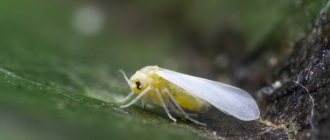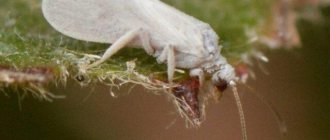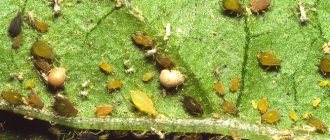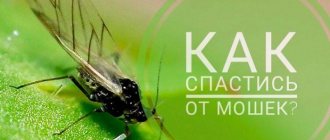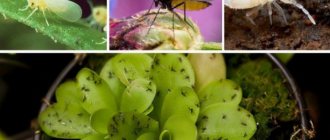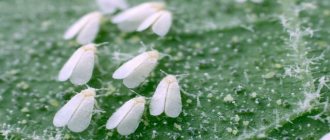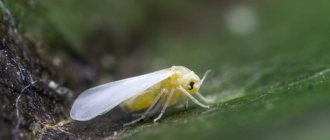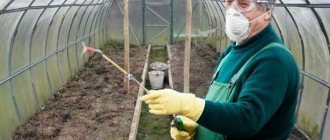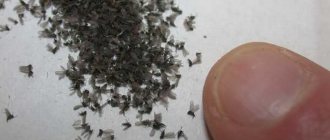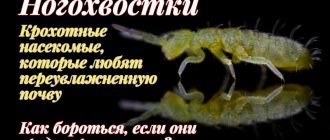Just yesterday the seedlings were pleased with their good health and lush appearance, but today the seedlings suddenly began to fold their “heads” en masse? One of the possible causes of trouble is whitefly leprosy. If this is your case, don't despair! We will tell you how to quickly defeat the enemy.
The whitefly harms vegetable and flower crops in summer cottages (usually in a greenhouse), but can easily settle in our homes. The threat of pest spread comes from poor-quality soil in which the seedlings grow, or from a houseplant recently arrived from a flower shop.
This voracious and prolific prankster can quickly destroy all the seedlings and dispel the dream of a rich harvest. Therefore, when you notice the first signs of whitefly on seedlings, immediately go on the warpath.
Meet the whitefly
It is not difficult to distinguish whiteflies from other seedling pests. Adults look like tiny snow-white moths - their body length does not exceed 3 mm. They usually huddle on the inside of leaves and, at the slightest alarm, fly up above the plants.
Here the seedling moth, as the whitefly is also called, lays eggs and reproduces. It is difficult to see the eggs and larvae with the naked eye - they are very small. The fertility of females is amazing: one individual can give birth to two hundred recruits, who immediately begin to cause mischief.
In the warmth of the room, the whitefly feels excellent, especially if an inexperienced gardener sins by excessively watering the seedlings, rarely ventilates the room and does not adhere to the optimal planting scheme. Under such conditions, the pest awakens a ravenous appetite and an insatiable desire to reproduce.
Using traps
Whitefly traps can be purchased at a specialty store. They are yellow cardboard, which is impregnated with a special glue that is not dangerous to people. A pest that finds itself on the surface of the trap sticks tightly to it. In addition, these devices can be used to catch other insects, such as, for example, fungus gnats or spider mites.
In search of a way to get rid of whiteflies on flowers, almost all gardeners make similar traps on their own. Production requires a sheet of bright yellow cardboard, which must be coated with a mixture of castor oil, petroleum jelly, honey and rosin. The trap must hang near the flowerpot on an iron or wood holder. They can also be installed in greenhouses - for a room of 10 square meters. Just one trap is enough.
Why is whitefly dangerous?
Both adult individuals and whitefly larvae can be easily compared to powerful pumps - they are so voracious. Bugs suck the juices from the leaves and shoots of plants, quickly undermining their health. The pest’s favorite delicacy is the tender tissues of tomato seedlings. But he does not disdain other crops: seedlings of cucumbers, zucchini, peppers, eggplants, flowers, etc.
A secretive lifestyle gives the enemy a head start. Insects manage to breed in countless numbers and cause serious damage to seedlings. The presence of a pest can be determined indirectly:
- seedlings are lagging behind in development and look depressed;
- seedling shoots become brittle;
- leaves become covered with pale yellow spots, curl and dry out;
- A sticky coating appears on the shoots and leaves.
Sticky secretions, which insects often leave on the inside of leaf blades, add even more problems, since they become a favorable environment for the proliferation of spores of fungal diseases. Among other things, the seedling moth is a carrier of dangerous viral plant infections that cannot be cured.
What plants does the pest attack?
The insect damages more than 300 plant species. Tomatoes are the most susceptible to whitefly among vegetables . From them she can switch to cucumbers, squash, pumpkins, and eggplants . Loves cabbage, strawberries, beans, salad .
It does not ignore fruit and berry crops: pear, plum, apple tree, raspberry, currant, gooseberry, honeysuckle .
Indoor flowers need to be protected from pests all year round: begonia, pelargonium, fuchsia, balsam, myrtle, poinsettia, gerbera, cacti, orchids, cyclamen, calla lilies, primroses . Damages garden flowers: aster, gladioli, tobacco, zinnia .
Different types of whiteflies cannot reproduce on the same plant, since their secretions repel each other.
How to get rid of whiteflies
If you recognize the enemy who has settled on your windowsill “by sight”, immediately launch an attack. It’s up to you to decide which method of controlling whiteflies you choose.
Folk remedies for whitefly
Play on the pest's sensitive sense of smell and give him unbearable aromatherapy. Spray the seedlings with odorous agents every 4-5 days, alternating them with each other:
- yarrow infusion (3-4 tbsp of dry crushed herb, pour 1 liter of water, leave for 2-3 days);
- infusion of wormwood (2-3 tbsp per 1 liter of water, leave for 2 days);
- tansy infusion (3 tablespoons per 1 water, leave for 2-3 days);
- infusion of garlic (2 tablespoons of cloves passed through a press, pour 1 liter of water, leave for 3-4 days);
- infusion of tobacco dust (5-6 tbsp per 1 liter of water, leave for 3-4 days).
Another trick is to regularly wash off the sticky coating along with eggs and larvae from the inside of plant leaves. First, bathe the seedlings in the shower to knock off the adults with a stream of water. Then dissolve 3-4 tbsp in 0.5 liters of water. liquid laundry (or better yet, tar) soap and using a sponge, carefully wash the foliage with this solution. This method is effective, but is more suitable for adult “thick-skinned” seedlings, for example, for seedlings of peppers, eggplants, cucumbers, etc.
To combat whiteflies, you can use a fumigator charged with a mosquito repellent plate or liquid. Close the door and windows in the room where the seedlings are located and leave the fumigator on overnight. By morning there will be no trace left of the pests.
Moths are partial to the color yellow - take advantage of their weakness. Hang pieces of plywood over the seedlings, having previously painted them with yellow paint, or buy yellow tags (markers) on long legs at the store and stick them into the ground.
Lubricate the surface of the traps with something sticky, such as honey or Vaseline. Periodically remove the old portion of the adhesive with the butterflies stuck in it and renew its layer.
Biological products for whitefly
In the fight against whitefly, ready-made biological preparations from a gardening store will come to the rescue. Such products will delight you not only with their effectiveness, but also with their relative safety, which is important when used at home.
To treat affected seedlings, use a solution of Verticillin, Lepidocide, Inta-Vir or Fitoverm. Prepare the working solution strictly according to the instructions for the selected preparation and when spraying seedlings, pay special attention to the inner surface of the leaf blades.
Chemicals for whiteflies
If the whitefly has managed to breed in large numbers, and not only the health, but also the life of the seedlings is at stake, take chemical insecticides into service. Aktara, Aliot, Konfidor, Iskra Zolotaya and others have proven themselves to be excellent in this matter. Such products are highly effective, but due to their toxicity they require caution when used.
It is better to treat seedlings with a chemical solution in the fresh air (in warm weather) or on a balcony, in a greenhouse, or a barn. At the same time, do not forget about personal protective equipment: gloves, goggles, respirator, work clothes.
Description and life cycle of the pest
Whitefly is a dangerous and common pest. Externally, this insect looks like a white moth. The adult has a flat oval, yellow-red, greenish or white body, 2–3 mm long. Two pairs of narrow wings are covered with a white waxy coating. The insect has a good reaction; when shaking the leaves, many midges quickly fly up.
The pest family includes more than 1,500 species. The biggest problem for gardeners in greenhouses and at home is the greenhouse whitefly. This is a polyphagous species native to South America, omnivorous and voracious, like a locust. The insect loves a warm and humid microclimate. In such conditions, the whitefly reproduces all year round.
Strawberry, cabbage, and honeysuckle whiteflies are found in the garden . These species are less dangerous, since they are not as prolific as the greenhouse species and do not massively damage different crops. In the southern regions, tobacco and citrus whiteflies .
In open ground, the pest is active only in the summer. The insect overwinters in the form of larvae and eggs , managing to lay them in secluded places: in unheated greenhouses, in the soil, under the bark of trees.
The peak of rapid reproduction occurs in summer. Females lay 20 to 280 gray ring-shaped eggs . Of these, after 1.5 weeks, translucent larvae , no more than 1 mm in size. They are the ones that harm plants the most.
At the next stage, the larvae turn into nymphs , from which adults (imago) . The full cycle from the larval stage to the formation of an adult lasts 3–4 weeks . 80–90% of larvae survive to butterfly status.
The next generation also produces offspring. During the summer the breeding cycle is repeated several times. On one plant, the pest can be present in all stages. On average, at an air temperature of 18–24°C, the whitefly lives 17–24 days. When this indicator increases to 30°C, life expectancy decreases to 4 days.
Preventing the appearance of whiteflies
After successful military operations, work on your mistakes and remember simple rules that will help you avoid pest invasion in the future:
- Use a substrate from a trusted manufacturer for planting seedlings, and be sure to disinfect your own prepared soil mixture before use;
- adhere to the correct planting scheme - the whitefly feels at ease in the seedling jungle;
- do not overdo it with watering - the pest has a special love for high humidity;
- regularly ventilate the room where the seedlings are located;
- maintain optimal air temperature when growing seedlings;
- Keep recently purchased indoor flowers away from seedlings - quarantine them in another room for 4-5 weeks.
We hope our tips will help you protect your seedlings from the machinations of whiteflies and allow you to make your dream of a decent harvest come true. And if you know other methods of combating this insidious pest, share your experience in the comments.
Main prerequisites for infection
Whiteflies almost always attack plants that are grown under:
- the highest temperature;
- high humidity;
- excessive density of plants;
- stale air.
Often the pest settles in greenhouses, where all the reasons listed above are located. Whiteflies also feel comfortable in mini-greenhouses that apartment owners set up on windowsills for the purpose of feeding seedlings.
Therefore, at high humidity temperatures, you need to pay attention to the natural movement and flow of fresh air. In addition, the source of infection can be purchased soil or already infected plants. The most common and obvious method for a pest to enter an apartment is an open window or vent.
Preventive actions
In order for garden and vegetable crops to produce a good harvest, it is necessary to maintain order in the summer cottage.
Order in the area
- Burn vegetable waste in a timely manner,
- and carry out any spraying on windless days,
- Different products should be alternated, otherwise pests will get used to them.
Try to spray plants in the evening to prevent burns, choose folk recipes that are safe for humans and nature.
Chemicals are used only in exceptional cases when the entire garden is severely affected.
Means of struggle
Chemical and biological drugs
With a one-time use of chemicals, the pest will not completely die - the adults and some of the larvae. After 6–7 days, the plants need to be sprayed again. The solution should fall on the lower part of the leaves, since this is where the main concentration of insects is.
Before treating with any preparation, the soil is moistened, severely damaged leaves are removed. To avoid addiction, chemicals are not used more than 2 times in a row.
Aktara
Pesticide in the form of odorless granules. For greater effect, it is recommended to treat the leaves and soil with the drug 3 times with a break of 7–10 days. Dosage for spraying leaves – 1 g per 1.5 l of water, for watering the soil around indoor plants and ornamental crops with tender leaves – 1 g per 10 l of water, for plants with hard leaves and semi-lignified shoots – 1 g per 2.5– 3 liters of water.
Features of the pest
The pest reproduces freely and lives only in humid, warm climates. The whitefly often overwinters in greenhouses or conservatories.
The life of one individual is 30 days. During her life, a female can lay from 85 to 130 eggs. Pest eggs can be identified by their placement in the shape of a circle. Eggs may be laid in crowds or in solitary rings. Initially, the clutch is yellow, but after 9 days the eggs turn black and enlarge.
Whitefly larvae have 4 stages of development:
The larvae, using glands, secrete a special sticky liquid, attach to the food leaf and tuck their legs under them. In this position they exist until they are fully formed. The formed butterflies are already very mobile; they take off when they stir the leaves of the plant and actively absorb young shoots.
Most often, whitefly affects:
Ways of plant infection:
